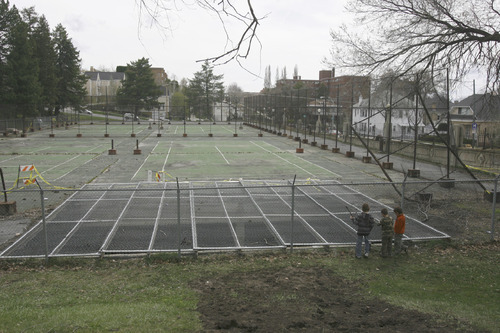This is an archived article that was published on sltrib.com in 2010, and information in the article may be outdated. It is provided only for personal research purposes and may not be reprinted.
Bordered by a sweeping concrete wall and dotted with young trees, the southwest corner of Reservoir Park was peaceful on a recent morning. Only a line of footprints disturbed the surface of a newly fallen layer of springtime snow.
A year ago, the scene at 1300 East and 100 South in Salt Lake City would have been very different. Instead of a wide-open green space, the approximately football-field-sized area was covered by a decrepit set of tennis courts.
The project to demolish the courts is nearly finished. There is new grass and a sprinkling of young trees, along with a new sidewalk on the park's border with 100 South.
In their heyday, the tennis courts were a haven in the middle of the city's east side, said university neighborhood council chairwoman Esther Hunter.
"It was just this incredible feeling of being in the very special place in the center of the city," she said. "What we've gotten back is this space in the middle of the city that's so green. We don't have a lot of green space anymore."
The park was named for a reservoir built in the late 1800s, one of the first built to serve the city's growing population, according to a National Register of Historic Places report.
The reservoir was covered with a concrete cap in 1956, after the federal government required reservoirs to be covered to protect the water supply, said Bob Sperling, manager of the water design team for Salt Lake City public utilities. The courts went up on top of the cap. They were open until the mid-1990s, when the reservoir was closed.
"We were concerned about structural challenges, maybe it might collapse," Sperling said.
The reservoir was drained, but the cap — and the courts on top — were left in place because there wasn't money to demolish them.
For roughly the next 15 years, the fence stayed in place and the courts sat empty.
Then last year, the city got an offer it couldn't refuse: Cheap fill dirt from a construction project at the nearby University of Utah.
The fears of structural weakness were justified when a 20-by-20-foot slab of concrete buckled and fell into the empty tank as Sperling walked around the site to inspect it in February 2009.
As the project got under way, the community council surveyed nearly 230 neighbors about what they would like to see there, Hunter said. Green space won by a wide margin.
Another important feature for residents and preservationists was the 500-foot historical wall that separates the park from 1300 East. Built in 1914, "to keep cars from running into the reservoir," as Sperling said, the wall is inlaid with a circular design and topped with wrought iron.
"It's a very active neighborhood park," said Nancy Boskoff, director of the Salt Lake City Arts Council, whose offices are located in the Art Barn at the park. Since the green space was finished this fall, she has seen people playing, walking their dogs and even cross country skiing in the space.
In all, the project cost about $575,000, Sperling said. There is some work left to be done, including new plantings, anti-graffiti treatment, new acorn lights on top of the wall and a kiosk showing the park's history.
But so far, neighbors are happy with the results, Hunter said.
"We're so excited," she said.









